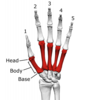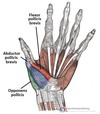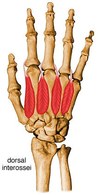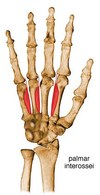S9) The Hand Flashcards
Identify and describe the bones of the wrist and hand
- Carpal bones – set of eight irregularly shaped bones located in the wrist area
- Metacarpals – five bones, each related to a digit
- Phalanges – each finger has three phalanges (thumb has two)

Identify the carpal bones according to their organisation proximally and distally
- Proximal row: scaphoid, lunate, triquetrum, pisiform
- Distal row: trapezium, trapezoid, capitate, hamate

Describe the proximal and distal articulations of the carpal bones
- Proximal: scaphoid and lunate articulate with the radius
- Distal: carpal bones articulate with the metacarpals

Describe the arrangement of the metacarpal bones
- Metacarpal I – thumb
- Metacarpal II – index finger
- Metacarpal III – middle finger
- Metacarpal IV – ring finger
- Metacarpal V – little finger

Describe the proximal and distal articulations of the metacarpal bones
- Proximal: metacarpals articulate with the carpal bones
- Distal: metacarpals articulate with the proximal phalanges

Describe the structure of the metacarpal bones in the hand
- Each metacarpal consists of a base, shaft and a head
- The medial and lateral surfaces of the metacarpals are concave, allowing attachment of the interossei muscles

The phalanges are the bones of the fingers.
Describe their structure
- Four fingers have proximal, middle and distal phalanges
- Thumb has proximal and distal phalanges

Describe the distribution of the radial and ulnar arteries in the hand
- Radial artery – contributes mainly to supply of the thumb and the lateral side of the index finger
- Ulnar artery – contributes mainly to the supply of the rest of the digits, and the medial side of the index finger
Describe the anatomical course of the ulnar artery in the hand
- The ulnar artery moves into the hand anteriorly to the flexor retinaculum, and laterally to the ulnar nerve
- It forms the superficial palmar arch and the deep palmar branch
- The superficial palmar arch gives rise to palmar digital arteries and then anastamoses with a branch of the radial artery

Where is the superficial palmar arch found?
The superficial palmar arch is found superficial to the flexor tendons in the hand and deep to the palmar aponeurosis

Describe the anatomical course of the radial artery in the hand
- The radial artery enters the hand dorsally through the floor of the anatomical snuffbox and turns medially to move between the heads of the adductor pollicis
- The radial artery then anastamoses with the deep palmar branch of the ulnar artery, forming the deep palmar arch, which gives rise to five common digital arteries

What is the Allen’s test?
- The Allen test is a worldwide test used to determine whether the patency of the radial or ulnar artery is normal
- It is performed prior to radial cannulation or catheterisation, because placement of such a catheter often results in thrombosis
- Thus, the test is used to reduce the risk of ischaemia to the hand

How does one interpret the result of the Allen’s test?

A positive Allen’s test means that the patient does not have dual blood supply to the hand, which is a negative indication for catheterisation or removal of the radial arteries
What are the two types of muscles of the hand?
- The extrinsic muscles
- The intrinsic muscles
Where are the two diffferent types of muscles of the hand located?
- The extrinsic muscles are located in the anterior and posterior compartments of the forearm
- The intrinsic muscles of the hand are located within the hand itself
What do the two diffferent types of muscles of the hand do?
- Extrinsic muscles – they control crude movements and produce a forceful grip
- Intrinsic muscles – they are responsible for the fine motor functions of the hand
What are the thenar muscles?
The thenar muscles are three short muscles located at the base of the thumb

Identify the 3 thenar muscles


State the structure, function and innervation of the thenar muscles
- Structure: muscle bellies produce a bulge (thenar eminence)
- Function: fine movements of the thumb
- Innervation: median nerve

Describe the structure and function of the opponens pollicis muscle

- Structure: largest and deepest of the thenar muscles
- Function: opposes the thumb

State the origin and attachment of opponens pollicis

- Origin: tubercle of the trapezium and associated flexor retinaculum
- Attachment: lateral margin of the metacarpal I

Describe the structure and function of the abductor pollicis brevis muscle

- Structure: anterior to the opponens pollicis and proximal to the flexor pollicis brevis
- Function: thumb abduction

State the origin and attachment of the abductor pollicus brevis

- Origin: tubercles of the scaphoid and trapezium and associated flexor retinaculum
- Attachment: lateral side of proximal phalanx of the thumb




















































